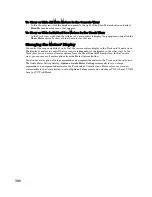
393
Engl
ish
Description of Interface Components
•
Edit mode—select the parameter you want to edit: pitch, time, formant, or dynamics.
•
Zoom—continuous horizontal or vertical zooming by dragging the center vertically or horizontally.
If you drag the center while pressing the Shift key, you can restrict the zoom direction to horizontal
or vertical. Zoom In or Out incrementally by clicking any of the four arrows. Double-clicking the
center shows the overall clip.
•
AutoScroll—the editing display scrolls when you turn on AutoScroll.
•
Formant control—the Pitch Follow knob increases or decreases the formant according to pitch. The
Shift knob increases or decreases the formant for the entire phrase.
•
Pitch Correction
•
Keyboard and Scale buttons—assign the target notes with the keyboard button; each key has
a bypass button (B) located under or over the key. The Scale button lets you assign the target
notes by scale: click the Scale button, click Maj or Min, and click a note on the keyboard
button to choose the root of the scale.
•
Note button—use this button to set the rate of pitch correction. This function can adjust the
pitch to the selected notes’ grids by increasing or decreasing the pitch of the selected region.
•
Vibrato—set the depth of the vibrato. If you choose 100%, vibrato depth is set to zero.
•
Sense—this is a sensitivity control for pitch correction for unstable pitch areas such as
portamento. Pitch correction gets stronger if you increase the value.
•
Cent indicator—this indicator shows the pitch correction amount by cents in realtime (+/- 100
cents).
•
Timeline—this gives a graphical display of the playback time in beats.
•
Select pitch correction key—set the target notes for the pitch correction. Each time you click a note,
the note’s color is changed to red, grey, or blue in turn. Meaning of each color is as follows:
•
Blue: selected
•
Gray: not selected
•
Red: Bypassed
•
Arrow tool
—for selecting the editing region, and for increasing or decreasing the pitch of the
selected region.
•
Line tool
—for drawing Pitch, Formant, and Dynamics with straight lines.
•
Pen tool
—for drawing Pitch, Formant, and Dynamics freehand.
•
Vibrato/LFO tool
—for adding and editing Vibrato or LFO at the selected region.
•
Eraser
—for resetting the selected region to its initial value.
•
Hand tool
—for scrolling the display. If you drag in the editing area while pressing the Ctrl key,
you can zoom.
•
Rectangle zoom
—for selecting an area to zoom in to. Drag a border around the area you want
to zoom to. Overall area is displayed by double clicking.
Playing Back V-Vocal Clips
You can play back V-Vocal clips by clicking the buttons at the top of the V-Vocal interface. Besides
playing the V-Vocal clip, you can mute it, solo it, loop it, and rewind it. Clicking in the time ruler at the
top of the graph moves the playback time.
Summary of Contents for Cakewalk SONAR
Page 1: ...Cakewalk SONAR User s Guide ...
Page 2: ......
Page 4: ......
Page 22: ...xxii ...
Page 50: ...50 ...
Page 102: ...102 ...
Page 182: ...182 ...
Page 302: ...302 ...
Page 420: ...420 English ...
Page 466: ...466 ...
Page 502: ...502 ...
Page 574: ...574 ...
Page 580: ...580 ...
Page 608: ...608 ...
















































